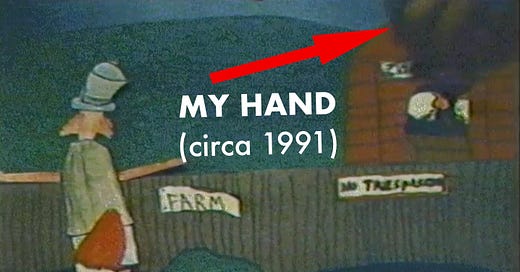When I was a kid, I used to make paper cut-out stop motion movies on my old Super-8 camera. When the film came back, I’d often discover my hand in the frame and have to splice it out.
But these days as I think about AI’s place in animation, I find myself drawn to some of the messier, more human approaches to the artform. I’m looking for those frames with the hand in shot.
In Kevin Roose’s excellent book Futureproof: 9 Rules for Surviving in the Age of AI he talks about the importance of leaving handprints in your work. With that in mind, here are four ways animation artists can make our art more human in the face of automation.
1. Be Unexpected
AI is the average of its trained data, so don’t be average! Zig where common sense says to zag. Could you place the eyes on the character there? How about there? How could that character turn their head in a way you haven’t seen in every other cartoon? Goodbye Milt Kahl headshake or Baloo rubbing the back of his neck.
2. Be More Wrong
Computers want to get it right. Declare your humanity boldly by getting it (just a bit) wrong. Make those shapes feel more organic. Make your in-betweens just a little off. And if you’re feeling crazy, ignore a hook-up if it’s going to make the shot funnier (to humans).
3. Interrupt The Machine
Find places to modify what the software fills in for you. Handcraft those in-betweens instead of letting the machine interpolate. Adjust the model in profile for more appeal. While you still have control, don’t let the machine do your job.
4. Draw from Life
Do this literally (staring at people over your sketchbook is an underrated hobby) but also draw your life experience into your work. Base a character or location on someone or somewhere you know, even if it’s just a small mannerism. I recently incorporated my older brother’s bagpipe playing and referenced an awkward photo of my father sitting on the beach into a cartoon. Large Language Models aren’t wandering around the streets living life (yet!) so make sure to use your unfair advantage.
Remember, having your hand in frame isn’t a mistake. It’s why we do this.
Until next time,
Matt Ferg.
ps. This is the first of my “Inbetweener” posts. Shorter dispatches from my life in the machine inbetween the longer ones. Hope you enjoy!





Great insight. I’d just add that there are AI models now that can learn almost any style, even subtle mannerisms. While the process is still quite complex, it’s evolving incredibly fast.